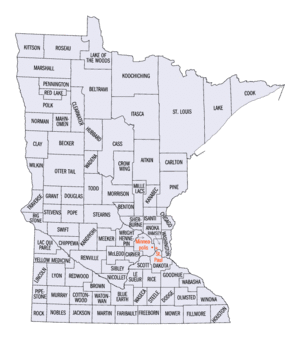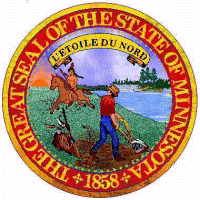Difference between revisions of "Minnesota"
(Add an interesting and important detail about Minnesota's Democratic politics.) |
|||
| Line 24: | Line 24: | ||
'''Minnesota''' is located in the Midwestern region of the [[United States]] and on May 11th, 1858 became the thirty-second state to enter into the union. During the [[American Civil War]] Minnesota supported the Union Army. The capital of Minnesota is [[Saint Paul (city)|Saint Paul]] and the largest city is [[Minneapolis]]. These cities are sometimes referred to as the [[Twin cities|Twin Cities]], due to their close proximity. The current governor of Minnesota is [[Tim Pawlenty]], a [[Republican]]. | '''Minnesota''' is located in the Midwestern region of the [[United States]] and on May 11th, 1858 became the thirty-second state to enter into the union. During the [[American Civil War]] Minnesota supported the Union Army. The capital of Minnesota is [[Saint Paul (city)|Saint Paul]] and the largest city is [[Minneapolis]]. These cities are sometimes referred to as the [[Twin cities|Twin Cities]], due to their close proximity. The current governor of Minnesota is [[Tim Pawlenty]], a [[Republican]]. | ||
| + | ==Climate== | ||
| + | Minnesota's climate ranges from hot, humid Summers to cold, snowy Winters. The state experiences all four seasons distinctly. Severe weather ranges from thunderstorms, hail and occasional tornadoes during the mid-Spring and Summer to subzero temperatures, heavy snowfalls and blizzards during the late-Fall, Winter and early-Spring. | ||
| + | |||
| + | ==Geography== | ||
| + | Minnesota is nicknamed "the Land of 10,000 Lakes" due to its large number of freshwater lakes. The actual number of lakes is about 11,842. The southern third and western edge of the state have very few lakes, but the rest of the state is dotted with small (less than 50 acres) to very large (over 100,000 acres) lakes only a few miles apart at most. The largest lake entirely within the state is Red Lake in Beltrami County, which is divided by a natural peninsula into Upper Red Lake and Lower Red Lake. The lake is 288,831 acres, or about 443.5 sq. miles, in size. The estimated total miles of shoreline of all of Minnesota's lakes is greater than the shorelines of California, Florida and Hawaii combined. As a result of this large number of lakes, Minnesota has a booming resort business, with over 1000 resorts of various kinds spread throughout the state. Year-round fishing is also a major draw for residents and visitors. | ||
| + | |||
| + | Excluding the southern border, a large portion of Minnesota's borders are defined by rivers and lakes. Big Stone Lake, Lake Traverse and the Red River compose most of the state's western border with North and South Dakota. The northern border with Canada is primarily defined by the Rainy River and Rainy Lake. Finally, the eastern border with Wisconsin includes Lake Superior and the St. Croix and Mississippi rivers. | ||
| + | |||
| + | The Mississippi River's headwaters are located at Lake Itasca in northern Minnesota. | ||
| + | |||
==Politics of Minnesota== | ==Politics of Minnesota== | ||
Minnesota has been historically a [[Democratic]] state. They have not gone Republican in a Presidential election since [[Richard Nixon]] in 1972. However, in recent years Minnesota has been trending more to the right in electing Governor Pawlenty and now former [[Senator]] [[Norm Coleman]]. The 2008 Republican National Convention was held in Saint Paul, Minnesota. | Minnesota has been historically a [[Democratic]] state. They have not gone Republican in a Presidential election since [[Richard Nixon]] in 1972. However, in recent years Minnesota has been trending more to the right in electing Governor Pawlenty and now former [[Senator]] [[Norm Coleman]]. The 2008 Republican National Convention was held in Saint Paul, Minnesota. | ||
Revision as of 02:31, September 3, 2009
| Capital | Saint Paul |
|---|---|
| Nickname | The North Star State |
| Official Language | None |
| Governor | Tim Pawlenty, R |
| Senator | Amy Klobuchar, D (202) 224-3244 Contact |
| Senator | Al Franken, D 202-224-5641 Contact |
| Population | 5,220,393 (est.) |
| Ratification of Constitution/or statehood | May 11, 1858 (32nd) |

|
Motto: L'Etoile du nord (The star of the north) |
Minnesota is located in the Midwestern region of the United States and on May 11th, 1858 became the thirty-second state to enter into the union. During the American Civil War Minnesota supported the Union Army. The capital of Minnesota is Saint Paul and the largest city is Minneapolis. These cities are sometimes referred to as the Twin Cities, due to their close proximity. The current governor of Minnesota is Tim Pawlenty, a Republican.
Climate
Minnesota's climate ranges from hot, humid Summers to cold, snowy Winters. The state experiences all four seasons distinctly. Severe weather ranges from thunderstorms, hail and occasional tornadoes during the mid-Spring and Summer to subzero temperatures, heavy snowfalls and blizzards during the late-Fall, Winter and early-Spring.
Geography
Minnesota is nicknamed "the Land of 10,000 Lakes" due to its large number of freshwater lakes. The actual number of lakes is about 11,842. The southern third and western edge of the state have very few lakes, but the rest of the state is dotted with small (less than 50 acres) to very large (over 100,000 acres) lakes only a few miles apart at most. The largest lake entirely within the state is Red Lake in Beltrami County, which is divided by a natural peninsula into Upper Red Lake and Lower Red Lake. The lake is 288,831 acres, or about 443.5 sq. miles, in size. The estimated total miles of shoreline of all of Minnesota's lakes is greater than the shorelines of California, Florida and Hawaii combined. As a result of this large number of lakes, Minnesota has a booming resort business, with over 1000 resorts of various kinds spread throughout the state. Year-round fishing is also a major draw for residents and visitors.
Excluding the southern border, a large portion of Minnesota's borders are defined by rivers and lakes. Big Stone Lake, Lake Traverse and the Red River compose most of the state's western border with North and South Dakota. The northern border with Canada is primarily defined by the Rainy River and Rainy Lake. Finally, the eastern border with Wisconsin includes Lake Superior and the St. Croix and Mississippi rivers.
The Mississippi River's headwaters are located at Lake Itasca in northern Minnesota.
Politics of Minnesota
Minnesota has been historically a Democratic state. They have not gone Republican in a Presidential election since Richard Nixon in 1972. However, in recent years Minnesota has been trending more to the right in electing Governor Pawlenty and now former Senator Norm Coleman. The 2008 Republican National Convention was held in Saint Paul, Minnesota.
Minnesota is the only state in the Union in which the national Democratic Party actually is represented by the state-level Democratic-Farmer-Laborer Party (DFL). All Democratic politicians in and from Minnesota work under the DFL header, though this now is an issue primarily of tradition than actual meaning.
| |||||

